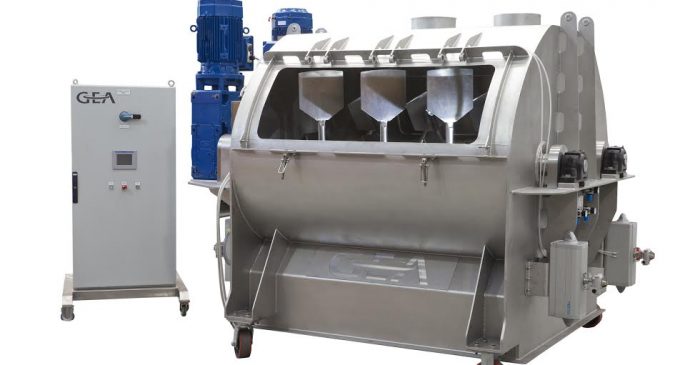Getting the Mix Right

For all food manufacturers, quality is key. Only by providing foods of consistently high quality can they build markets, keep increasingly discerning customers happy, and protect the vitally important image of globally recognized brands. The ability to mix powders and liquids homogenously is a key requirement. In this article, GEA looks at the key factors for achieving the uniform mixing of liquid and powder food products to ensure product safety, efficacy and lasting customer appeal.
Powder Mixing
Most powders, such as infant and adult formulas, are a combination of major, minor and micro ingredients that must be mixed in a precise ratio, in accordance with the required recipe. As these products are often consumed by the most vulnerable members of our society, ensuring product safety, ease of use and maximum nutritional benefit, is essential.
However, achieving a uniform mix can be difficult. Many micro ingredients, such as pro and pre-biotics, can represent only a small fraction of total product volume yet must be evenly dispersed throughout the product. Minor and micro ingredients often have a different mass and particle size to the major product and so homogeneity can be difficult to achieve and separation can occur during packing and storage. Some products can be dangerous to the consumer if the dose is wrong. It is also essential to achieve this homogeneity quickly, to maximize productivity and avoid damaging the product.
All manufacturers have rigorous quality control testing procedures that will identify if a product has failed to achieve the required uniformity of mix. Should this happen, entire batches can be rejected wasting time, money and valuable product.
Key Factor
According to GEA one of the key factors in achieving a uniform mix is the operation and integrity of the mixer itself. Mixing is the last possible point in the production process at which the customer can guarantee the accuracy of the product recipe and ensure that it meets regulatory guidelines. If the tolerances within the machine are insufficiently tight there will be an increase in ’product hang’ where product gets stuck in ‘dead’ areas of the mixer and not mixed properly. This potentially changes the recipe from that prescribed and can allow insufficiently mixed clumps of product to be discharged into the finished product.
To combat this problem GEA has invested heavily in recent years to ensure the rigidity of its mixers, thereby allowing extremely tight manufacturing tolerances therefore ensuring that the products can be mixed fully. GEA also favours a counter-rotating twin paddle mixing system that mechanically fluidizes the different powders as they are introduced, dragging them towards the centre of the mixer to create a light, fluffy, aerated fluid that ensures powders of different densities and particle size are mixed homogenously.
Fast Mixing
The twin paddle system also ensures fast mixing with product requiring only 60-90 seconds residency time compared with up to 15 minutes for other systems. This is important to reduce the stress on the product itself that can cause the breakdown of the powder’s agglomerated particles. If the particles are severely damaged during mixing, the wetting properties of the final product will be adversely affected so it will not dissolve as easily in use. Damage also affects the bulk density of the product so it coagulates at the bottom of the retail pack creating half-filled cans, making it unattractive and harder to use.
The GEA twin paddles are controlled by a unique synchronizing shaft, rather than by separate belt or chain drives, which ensures that the paddles always rotate as designed and can never experience a catastrophic, and potentially dangerous, failure.
 The process of ensuring a uniform mix does not stop, however, with the mixing itself. Care must be taken to ensure that the throughput of the mixer matches the capacity of downstream processes, such as conveying and packing. Product kept for long periods in bulk storage hoppers can begin to separate with heavy particles migrating under gravity. Similarly, conveying and filling operations must be performed carefully and gently to prevent damage and product separation. It is, therefore, important for the whole production system to be designed to work together to ensure the best possible security of outcome.
The process of ensuring a uniform mix does not stop, however, with the mixing itself. Care must be taken to ensure that the throughput of the mixer matches the capacity of downstream processes, such as conveying and packing. Product kept for long periods in bulk storage hoppers can begin to separate with heavy particles migrating under gravity. Similarly, conveying and filling operations must be performed carefully and gently to prevent damage and product separation. It is, therefore, important for the whole production system to be designed to work together to ensure the best possible security of outcome.
Liquid Processing and Mixing
Many food powders such as whole and skim milk, whey protein concentrates (WPC) and cocoa are used as ingredients in liquid suspensions and products such as milk-based drinks, yoghurt and food applications. These too have to be introduced into the mixer and homogenized carefully and effectively to ensure the stable shelf life and product characteristics manufacturers require.
Here too the integrity of the mixer is critical. Fundamental to the MIXING FORMULA™ mixers from GEA is a high sheer device that reduces oil and powder particles down to microns by forcing them through the narrow gap between the rotating (Rotator) and fixed (Stator) components, then homogenizes them under extreme pressure. Tolerances are small so the mixer’s design and rigidity is critical to achieving the desired result. The key, for both the INLINE FORMULA™ and BATCH FORMULA™ systems from GEA, is to ensure that all the products are forced through the high sheer device with tolerances so tight that there is no opportunity for any product to pass by.
To control the mechanical stress that’s applied to the product when passing through the High Shear Device – the stator is interchangeable and is chosen carefully for each application. Larger particles, such as fruit or vegetables, are added to the mix later as required, as part of a low shear blending process.
Vacuum System
The MIXING FORMULA™ concept, is often equipped with a vacuum system that draws powders into the mixing vessel, under the surface of the liquid. This ensures that: the powder is wetted instantly; no powder sticks to the sides of the vessel or agitator; and all powder is homogenized into the final product. By contrast, systems in which the powder is introduced onto the top of the liquid often suffer from ‘fish eyes’, clumps of powder that cannot be wetted even with long periods of agitation and will not, therefore, be fully homogenized.
Mixing is the most demanding unit operation in today’s process industries – and a high-quality end product is dependent on efficient, successful mixing. Choosing the right mixing technology is crucial – as the mixing process not only has an impact on the processing – but also on the batch cycle times, shelf life, plant efficiency, total cost of ownership (TCO) and the working environmental of employees.For further information visit www.gea.com.



































